Many people now realize the need to combat climate change, green energy. Green energy sources have emerged as a critical component of the global energy landscape.
Green energy, also known as renewable energy, refers to energy derived from sources that are naturally replenished and have a minimal impact on the environment. Unlike fossil fuels, which are finite and release harmful greenhouse gases when burned, green energy sources offer sustainable alternatives that reduce carbon emissions and promote a cleaner, healthier planet.
There are several types of green energy sources, each with its unique characteristics and potential. In this comprehensive article, we will explore the most prominent types of green energy and their contributions to a more sustainable future.
Solar Energy
Solar energy is perhaps the most recognizable and widely adopted form of green energy. It harnesses the power of the sun’s radiation through photovoltaic (PV) panels or solar thermal systems.
Photovoltaic panels convert sunlight directly into electricity, while solar thermal systems use sunlight to generate heat for various applications, including electricity generation and water heating.
Solar energy is abundant, clean, and accessible in most parts of the world, making it a promising source for both residential and commercial use.
Wind Energy
Wind energy utilizes the kinetic energy of moving air masses to generate electricity. We strategically place wind turbines in areas with consistent wind patterns, such as wind farms on land and offshore.
As the wind spins the turbine blades, they turn a generator, producing electricity. Wind energy is renewable, emissions-free, and has a relatively low environmental footprint once the turbines are installed. It has become a significant contributor to many countries’ energy mix.
Hydropower
Hydropower, also known as hydroelectric power, harnesses the energy of flowing or falling water to generate electricity.
Dams, rivers, and other water bodies are equipped with turbines that convert the water’s kinetic energy into electrical power. Hydropower is one of the oldest forms of renewable energy and is highly efficient and reliable.
However, its environmental impact can vary depending on the scale of the project and its effects on local ecosystems.
Biomass Energy
Biomass energy is derived from organic materials such as wood, agricultural residues, and even municipal solid waste.
These materials are burned or converted into biofuels like ethanol and biodiesel to produce heat, electricity, or transportation fuels. Biomass is considered renewable because it relies on the continuous growth of plants and trees.
However, sustainable practices are crucial to prevent deforestation and ensure the net reduction of greenhouse gas emissions.
Geothermal Energy
The energy from Geothermal comes from the Earth’s crust. Geothermal energy taps into the Earth’s internal heat by harnessing steam or hot water from underground reservoirs to generate electricity or provide direct heating.
Geothermal power plants are typically located in regions with high geothermal activity, such as geysers and hot springs.
This form of green energy is reliable and offers a constant source of power, making it suitable for base-load electricity generation.
Tidal and Wave Energy
The movement of the oceans powers this energy. Tidal and wave energy capture the kinetic energy of ocean tides and waves, respectively. Tidal power systems use the rise and fall of tides to drive turbines, while wave energy converters capture the energy from the motion of ocean waves.
These technologies are still in the experimental and development phases, but they hold great promise for coastal regions with significant tidal or wave resources.
Ocean Thermal Energy
Ocean thermal energy relies on the temperature difference between warm surface water and cold deep water to generate electricity.
This technology is less common but has potential in tropical regions where these temperature gradients are significant.
Ocean thermal energy conversion (OTEC) systems use a fluid with a low boiling point to drive a turbine and produce electricity.
Conclusion
The types of green energy sources discussed in this article represent a diverse array of sustainable options for meeting our energy needs while reducing our carbon footprint.
As we transition away from fossil fuels and embrace these renewable alternatives, it’s crucial to consider the specific characteristics and suitability of each energy source for different geographical regions and applications.
By harnessing the power of these green energy sources and investing in research and development, we can pave the way for a cleaner, more sustainable energy future and mitigate the impacts of climate change.

Comments (3)